Indium Mineralization in a Sn-Poor Skarn Deposit: A Case Study of the Qibaoshan Deposit, South China
Abstract
:1. Introduction
2. Regional and Local Geology
2.1. Regional Geology of Northeastern Hunan Province
2.2. Geology of the Qibaoshan Deposit
2.2.1. Stratigraphy
2.2.2. Intrusive Rocks
2.2.3. Orebodies in the Qibaoshan Deposit
2.2.4. Ore Types and Mineral Paragenetic Sequence
3. Sampling and Analyses
3.1. Sample Sites
3.2. Whole-Rock Geochemical Analyses
3.3. Electron-Probe Microanalyses
4. Indium Contents of Ores and Mineral Chemistry
4.1. Chemical Composition of Ores and Element Correlations
4.2. Chemistry of Sphalerite
5. Discussion
5.1. Correlation of Indium with Other Elements
5.2. Indium Distribution in the Qibaoshan Deposit
5.3. Indium Mineralization in Sn-Poor deposits
6. Conclusions
Acknowledgments
Conflicts of Interest
References
- Schwarz-Schampera, U.; Herzig, P.M. Indium: Geology, Mineralogy, and Economics; Springer: Berlin, Germany, 2002. [Google Scholar]
- Ishihara, S.; Hoshino, K.; Murakami, H.; Endo, Y. Resource evaluation and some genetic aspects of indium in the Japanese ore deposits. Resour. Geol. 2006, 56, 347–364. [Google Scholar] [CrossRef]
- Chakhmouradian, A.R.; Smith, M.P.; Kynicky, J. From “strategic” tungsten to “green” neodymium: A century of critical metals at a glance. Ore Geol. Rev. 2015, 64, 455–458. [Google Scholar] [CrossRef]
- Ishihara, S.; Endo, Y. Indium and other trace elements in volcanogenic massive sulfide ores from the Kuroko, Besshi and other types in Japan. Bull. Geol. Surv. Jpn. 2007, 58, 7–22. [Google Scholar] [CrossRef]
- Li, X.; Yang, F.; Chen, Z.; Bu, G.; Wang, Y. A tentative discussion on geochemistry and genesis of indium in Dachang tin ore district, Guangxi. Miner. Depos. 2010, 29, 903–914. (In Chinese) [Google Scholar]
- Ishihara, S.; Murakami, H.; Li, X. Indium concentration in zinc ores in plutonic and volcanic environments: Examples at the Dulong and Dachang mines, South China. Bull. Geol. Surv. Jpn. 2011, 62, 259–272. [Google Scholar] [CrossRef]
- Pi, Q.; Hu, R.; Wang, D.; Miao, D.; Qin, X.; Chen, H. Enrichment of indium in west ore belt of Dachang orefield: Evidence from ore textures and sphalerite geochemistry. Miner. Depos. 2015, 34, 379–396. (In Chinese) [Google Scholar]
- Ishihara, S.; Murakami, H.; Marquez-Zavalia, M. Inferred indium resources of the Bolivian tin-polymetallic deposits. Resour. Geol. 2011, 61, 174–191. [Google Scholar] [CrossRef]
- Oliveira, D.; Rosa, D.; Figueiredo, M. Renewable energy technologies for the 21st century: The Iberian Pyrite Belt as a possible supplier of indium. In Proceedings of the 9th Biennial SGA Meeting of the Society for Geology Applied to Mineral Deposits Meeting, Dublin, Ireland, 20–23 August 2007; pp. 1263–1266. [Google Scholar]
- Oliveira, D.; Rosa, D.; Matos, J.; Guimaraes, F.; Figueiredo, M.; Silva, T. Indium in the LagoaSalgada orebody, Iberian pyrite belt, Portugal. In Proceedings of the 10th Biennial SGA Meeting of the Society for Geology Applied to Mineral Deposits Meeting, Townsville, Australia, 17–20 August 2009; pp. 424–426. [Google Scholar]
- Oliveira, D.; Matos, J.; Rosa, C.; Rosa, D.; Figueiredo, M.; Silva, T.; Guimaraes, F.; Carvalho, J.; Pinto, A.; Relvas, J.; et al. The LagoaSalgada orebody, Iberian Pyrite Belt, Portugal. Econ. Geol. 2011, 106, 1111–1128. [Google Scholar] [CrossRef]
- Zhang, Q.; Zhu, X.; He, Y.; Jiang, J.; Wang, D. Indium enrichment in the Meng’entaolegai Ag-Pb-Zn deposit, Inner Mongolia, China. Resour. Geol. 2006, 56, 337–346. [Google Scholar] [CrossRef]
- Fouquet, Y.; von Stackelberg, U.; Charlou, J.L.; Erzinger, J.; Herzig, P.M.; Miihe, R.; Wiedicke, M. Metallogenesis in back-arc environments: The Lau basin example. Econ. Geol. 1993, 88, 2154–2181. [Google Scholar] [CrossRef]
- Binns, R.A.; Scott, S.D. Actively forming polymetallic sulfide deposits associated with felsic volcanic rocks in the Eastern Manus Back-Arc Basin, Papua New Guinea. Econ. Geol. 1993, 88, 2226–2236. [Google Scholar] [CrossRef]
- Fouquet, Y.; Wafik, A.; Cambon, P.; Mevel, C.; Meyer, G.; Gente, P. Tectonic setting and mineralogical and geochemical zonation in the Snake Pit sulfide deposit (Mid-Atlantic ridge at 23° N). Econ. Geol. 1993, 88, 2018–2036. [Google Scholar] [CrossRef]
- Kovalenker, V.A.; Laputina, I.P.; Znamenskii, V.S.; Zotov, I.A. Indium mineralization of the Great Kuril Island Arc. Geol. Ore Depos. 1993, 35, 491–495. [Google Scholar]
- Yudovskaya, M.A.; Distler, V.V.; Chaplygin, I.V.; Mokhov, A.V.; Trubkin, N.V.; Gorbacheva, S.A. Gaseous transport and deposition of gold in magmatic fluid: Evidence from the active Kudryavy volcano, Kurile Islands. Miner. Depos. 2006, 40, 828–848. [Google Scholar] [CrossRef]
- Liu, J.; Gu, X.; Shao, Y.; Feng, Y.; Lai, J. Indium mineralization in copper—Tin stratiform skarn ores at the Saishitang—Rilonggou ore field, Qinghai, Northwest China. Resour. Geol. 2016, 66, 351–367. [Google Scholar] [CrossRef]
- Liang, T.; Wang, D.; Cai, M.; Fan, S.; Yu, Y.; Wei, K.; Huang, H.; Zheng, Y. Metallogenic characteristics and ore-forming regularity of metallic deposits along Nandan-Hechi metallogenic belt in Northwestern Guangxi. Miner. Depos. 2014, 33, 1171–1192. (In Chinese) [Google Scholar]
- Li, Y.; Tao, Y.; Zhu, F.; Liao, M.; Xiong, F.; Deng, X. Distribution and existing state of indium in the Gejiu tin polymetallic deposit, Yunnan Province, SW China. Chin. J. Geochem. 2015, 34, 469–483. [Google Scholar] [CrossRef]
- Cheng, Y.; Mao, J.; Liu, P. Geodynamic setting of Late Cretaceous Sn–W mineralization in southeastern Yunnan and northeastern Vietnam. Solid Earth Sci. 2016, 1, 79–88. [Google Scholar] [CrossRef]
- He, S.; Han, G.; Sun, M.; Hong, Z. Preliminary study of dispersed elements in the Qibaoshan polymetallic ore deposit, Hunan. Geol. Rev. 1985, 81, 143–148. (In Chinese) [Google Scholar]
- Qian, D.; Zhang, S.; Wang, Z. The Discovery History of Mineral Deposits of China (Hunan Volume); Geological Publishing House: Beijing, China, 1996. (In Chinese) [Google Scholar]
- Ishihara, S.; Qin, K.; Wang, Y. Resource evaluation of indium in the Dajing tin-polymetallic deposits, Inner Mongolia, China. Resour. Geol. 2008, 58, 72–79. [Google Scholar] [CrossRef]
- Liu, H.; Zhang, L.; Jin, W.; Shen, K.; Gao, Y. The Yanshanian granitoids in northeast Hunan. Geol. Miner. Resour. South China 1999, 15, 1–9. (In Chinese) [Google Scholar]
- Jin, W.; Liu, H.; Zhang, L.; Shen, K. Study on rock-and ore-controlling structures in northeastern Hunan Province. Geol. Miner. Resour. South China 2000, 16, 51–57. (In Chinese) [Google Scholar]
- He, Z.; Xu, D.; Chen, G.; Xia, B.; Li, P.; Fu, G. Gold-polymetallic ore-forming geochemistry of Yanshanian intracontinental collision orogen, northeastern Hunan Province. Miner. Depos. 2004, 23, 39–51. (In Chinese) [Google Scholar]
- Lu, Y.; He, S. Geology and Metallogeny of the Qibaoshan Polymetallic Ore Deposit in Liuyang County, Hunan Province; No. 402 Geological Team of the Hunan Bureau of Geology and Mineral Resources: Changsha, China, 1984. (In Chinese)
- Xu, D.; Wang, L.; Li, P.; Chen, G.; He, Z.; Fu, G.; Wu, J. Petrogenesis of the Lianyunshan granites in northeastern Hunan Province, South China, and its geodynamic implications. Acta Petrol. Sin. 2009, 25, 1056–1078. (In Chinese) [Google Scholar]
- Li, P.; Chen, G.; Xu, D.; He, Z.; Fu, G. Petrological and geochemical characteristics and petrogenesis of neoproterozoic peraluminous granites in Northeastern Hunan Province. Geotecton. Metallog. 2007, 31, 126–136. (In Chinese) [Google Scholar]
- Li, P.; Xu, D.; Chen, G.; Xia, B.; He, Z.; Fu, G. Constraints of petrography, geochemistry and Sr-Nd isotopes on the Jinjing granitoids from northeastern Hunan Province, China: Implications for petrogenesis and geodynamic setting. Acta Petrol. Sin. 2005, 21, 921–934. (In Chinese) [Google Scholar]
- Shen, C.; Mei, L.; Min, K.; Raymond, J.; Lothar, R.; Yang, Z.; Peng, L.; Liu, Z. Multi-chronometric dating of the Huarong granitoids from the middle Yangtze Craton: Implications for the tectonic evolution of eastern China. J. Asian Earth Sci. 2012, 52, 73–87. [Google Scholar] [CrossRef]
- Ji, W.; Lin, W.; Michel, F.; Chen, Y.; Chu, Y.; Xue, Z. Origin of the Late Jurassic to Early Cretaceous peraluminous granitoids in the northeastern Hunan Province (middle Yangtze region), South China: Geodynamic implications for the Paleo-Pacific subduction. J. Asian Earth Sci. 2016, in press. [Google Scholar] [CrossRef]
- Liu, H.; Jin, W.; Zhang, L.; Shen, K. Discussion on sources of metallogenetic materials of porphyry-type and hydrothermal copper deposits in northeastern Hunan Province. Geol. Miner. Resour. South China 2001, 17, 40–47. (In Chinese) [Google Scholar]
- Fu, G.; Xu, D.; Chen, G. New recognitions on geological characteristics of gold ore deposits in northeastern Hunan Province, China and new prospecting advances. Geotecton. Metallog. 2002, 26, 416–422. (In Chinese) [Google Scholar]
- Deng, T.; Xu, D.; Chi, G.; Wang, Z.; Jiao, Q.; Ning, J.; Dong, G.; Zou, F. Geology, geochronology, geochemistry and ore genesis of the Wangu gold deposit in northeastern Hunan Province, Jiangnan orogen, of South China. Ore Geol. Rev. 2017, in press. [Google Scholar] [CrossRef]
- Xu, D.; Deng, T.; Chi, G.; Wang, Z.; Zou, F.; Zhang, J.; Zou, S. Gold mineralization in the Jiangnan orogenic belt South China: Geological, geochemical and geochronological characteristics, ore deposit-type and geodynamic setting. Ore Geol. Rev. 2017, in press. [Google Scholar] [CrossRef]
- Wang, Y.; Zhu, J.; Yu, Q. Geology of Lead-Zinc Deposits in Hunan Province; Geological Publishing House: Beijing, China, 1988. (In Chinese) [Google Scholar]
- Yi, Z.; Luo, X.; Zhou, D.; Xiao, C. Geological characteristics and genesis of Jinchong Co-Cu polymetallic deposit, Liuyan, Hunan Province. Geol. Miner. Resour. South China 2010, 26, 12–18. (In Chinese) [Google Scholar]
- Wang, Z.; Xu, D.; Chi, G.; Shao, Y.; Lai, J.; Deng, T.; Guo, F.; Wang, Z.; Dong, G.; Ning, J.; Zou, S. Mineralogical and isotopic constraints on the genesis on the Jingchong Co-Cu polymetallic in northeastern Hunan Province, South China. Ore Geol. Rev. 2017, in press. [Google Scholar] [CrossRef]
- Lu, Y.; Yin, H.; Shen, R. Genetic model of the Qibaoshan polymetallic ore deposit in Hunan Province. Miner. Depos. 1984, 3, 53–60. (In Chinese) [Google Scholar]
- Hu, X.; Peng, E.; Sun, Z. Geological characteristics and genesis of the Qibaoshan Cu-polymetallic deposit. Geotecton. Metallog. 2000, 24, 365–370. (In Chinese) [Google Scholar]
- Yang, R.; Fu, G.; Chen, B.; Chen, J.; Si, C.; Liu, B.; Zheng, Z. Qibaoshan Cu-polymetallic deposit in Hunan Province and its prospecting orientation. Geol. Miner. Resour. South China 2015, 31, 246–252. (In Chinese) [Google Scholar]
- He, S.; Sun, M. The study of polymetallic ore characteristics and useful elements in Qibaoshan. Geol. Prospect. 1986, 22, 28–35. (In Chinese) [Google Scholar]
- Zhang, G.; Liu, R. Evaluation for mine geological environment of the Xiaoqibaoshan Cu-Zn deposit in Liuyang, Hunan. Land Resour. Her. 2006, 3, 35–37. (In Chinese) [Google Scholar]
- Hu, J.; Xu, D.; Zhang, K. Zircon U-Pb dating, Hf isotope of magmatic rocks from the Qibaoshan Cu polymetallic deposit, Hunan. Geol. Miner. Resour. South China 2015, 31, 236–245. (In Chinese) [Google Scholar]
- Hu, J.; Xu, D.; Zheng, K. Geochemistry of quartz-porphyry and its relationship with mineralization in the Qibaoshan deposit, Hunan Province. Geol. Miner. Resour. South China 2012, 28, 298–306. (In Chinese) [Google Scholar]
- Hu, X.; Xiao, X.; Yang, Z. Geological and geochemical features of the Qibaoshan granite-porphyry. J. Cent. South Univ. Technol. 2002, 33, 552–554. (In Chinese) [Google Scholar]
- Hu, X.; Yang, Z. Ore-forming fluid characteristics and evolution process of the Qibaoshan Cu-polymetallic deposit in Liuyang, Hunan. Geol. Prospect. 2003, 39, 22–25. (In Chinese) [Google Scholar]
- Han, G.; He, S.; Sun, M.; Huang, Z. Gold and silver minerals and forming condition in polymetallic ore deposit from Qibaoshan, Liuyang, Hunan. J. Miner. Petrol. 1985, 6, 97–103. (In Chinese) [Google Scholar]
- Sun, M.; Han, G.; He, S.; Huang, Z. Tetradymite in Liuyang ore deposit. Acta Miner. Sin. 1985, 5, 76–79. (In Chinese) [Google Scholar]
- He, S. Joseite-B in the Qibaoshan polymetallic deposit. Hunan Geol. 1993, 12, 43–45. (In Chinese) [Google Scholar]
- Zheng, L.; Gu, X.; Cao, H.; Li, Q. Geological and geochemical characteristics of the Qibaoshan Ca-skarn and Mg-skarn intergrowth-type polymetallic deposit in Hunan Province. Geoscience 2014, 28, 87–97. (In Chinese) [Google Scholar]
- Yang, Z.; Peng, S.; Hu, X.; Li, C. Ore-forming fluid inclusion characteristics and metallogeny of the Qibaoshan Cu-polymetallic deposit in Liuyang, Hunan. J. Earth Sci. Environ. 2004, 26, 11–15. (In Chinese) [Google Scholar]
- Liu, J.; Rong, Y.; Gu, X.; Shao, Y.; Lai, J.; Chen, W. Indium mineralization in the Yejiwei Sn-polymetallic deposit of the Shizhuyuan Orefield, southern Hunan, China. Resour. Geol. 2007. submitted. [Google Scholar]
- Andersen, J.C.Ø.; Stickland, R.J.; Rollinson, G.K.; Shail, R.K. Indium mineralisation in SW England: Host parageneses and mineralogical relations. Ore Geol. Rev. 2016, 78, 213–238. [Google Scholar] [CrossRef]
- Ishihara, S.; Matsueda, H. Chemical characteristics of the indium-polymetallic ores from the Toyoha mine, Hokkaido, Japan. Bull. Geol. Surv. Jpn. 2011, 62, 131–142. [Google Scholar] [CrossRef]
- Murakami, H.; Ishihara, S. Trace elements of indium-bearing sphalerite from tin-polymetallic deposits in Bolivia, China and Japan: A femto-second LA-ICPMS study. Ore Geol. Rev. 2013, 53, 223–243. [Google Scholar] [CrossRef]
- Zhang, Q.; Zhu, X.; He, Y.; Zhu, Z. In, Sn, Pb and Zn contents and their relationships in ore-forming fluids from some In-rich and In-poor deposits in China. Acta Geol. Sin. 2007, 81, 450–462. [Google Scholar]
- Sinclair, W.D.; Kooiman, G.J.A.; Martin, D.A.; Kjarsgaard, I.M. Geology, geochemistry and mineralogy of indium resources at Mount Pleasant, New Brunswick, Canada. Ore Geol. Rev. 2006, 28, 123–145. [Google Scholar] [CrossRef]
- Cook, N.J.; Sundblad, K.; Valkama, M.; Nygård, R.; Ciobanu, C.L.; Danyushevsky, L. Indium mineralization in A-type granites in southeastern Finland: Insights into mineralogy and partitioning between coexisting minerals. Chem. Geol. 2011, 284, 62–73. [Google Scholar] [CrossRef]
- Simons, B.; Andersen, J.C.Ø.; Shail, R.K.; Jenner, F. Fractionation of Li, Be, Ga, Nb, Ta, In, Sn, Sb, W and Bi in the peraluminous Early Permian Variscan granites of the Cornubian Batholith: Precursor processes to magmatic-hydrothermal mineralization. Lithos 2017, 278, 491–512. [Google Scholar] [CrossRef]
- Seifert, T.; Sandmann, D. Mineralogy and geochemistry of indium-bearing polymetallic vein-type deposits: Implications for host minerals from the Freiberg district, Eastern Erzgebirge, Germany. Ore Geol. Rev. 2006, 28, 1–31. [Google Scholar] [CrossRef]

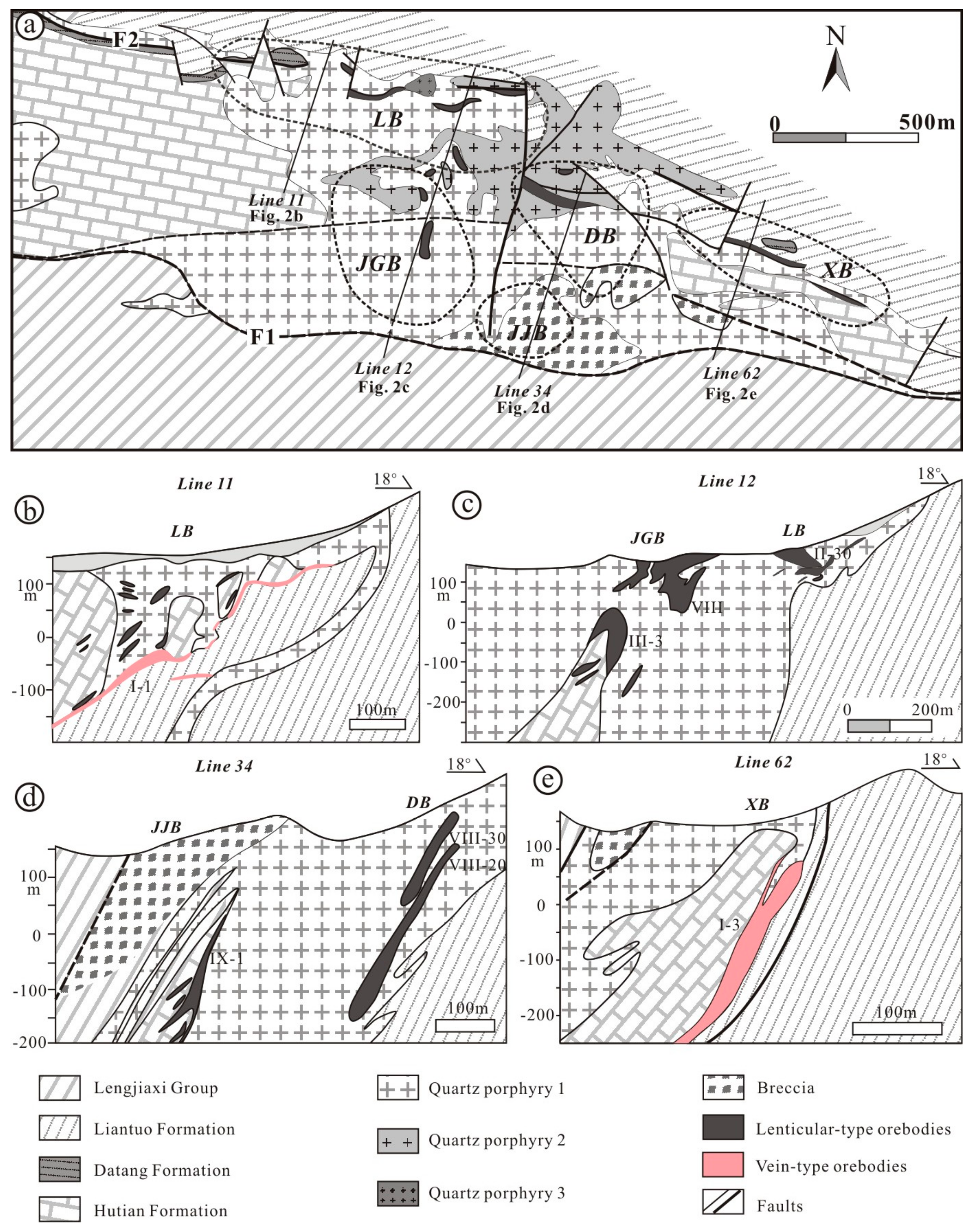
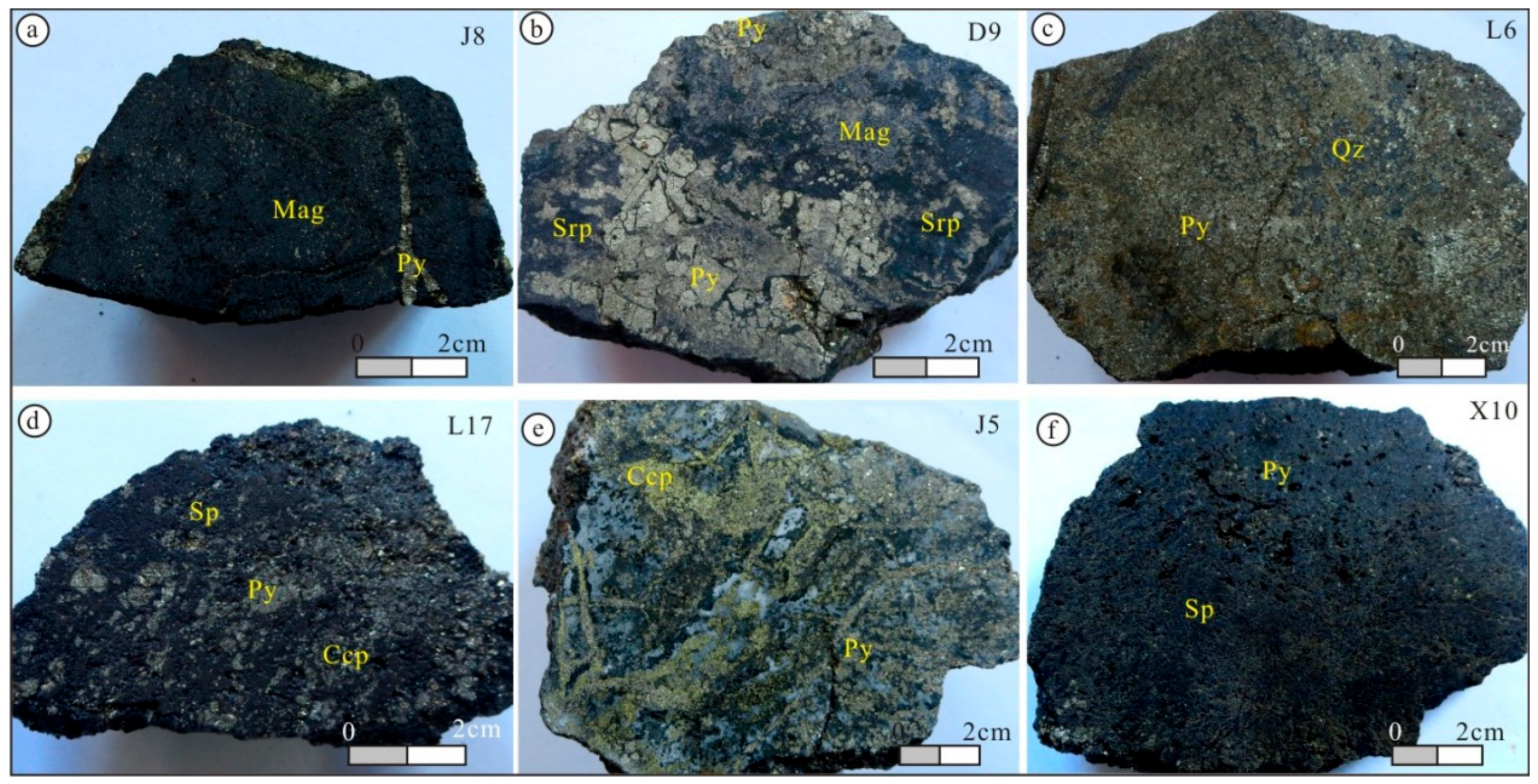
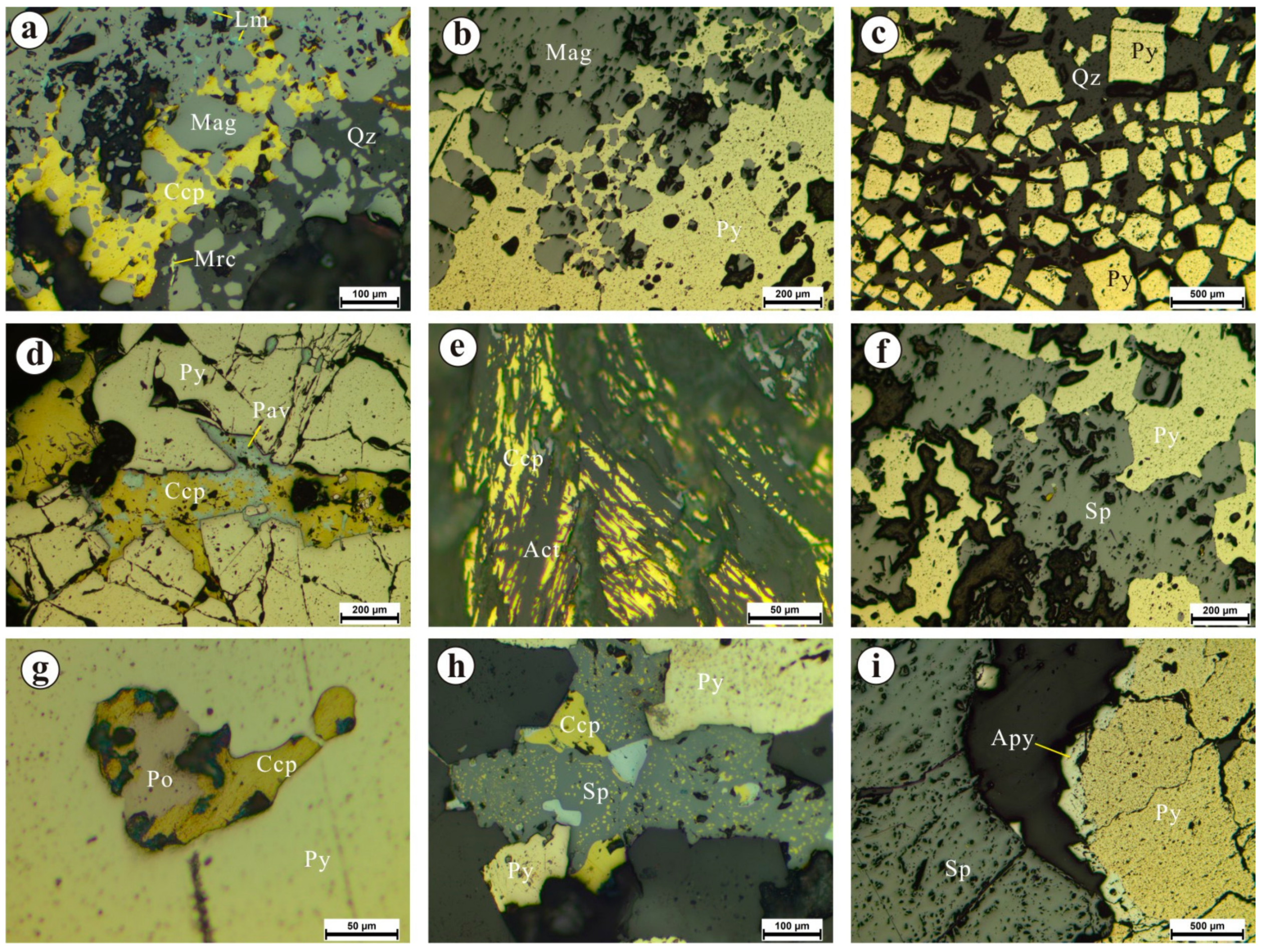
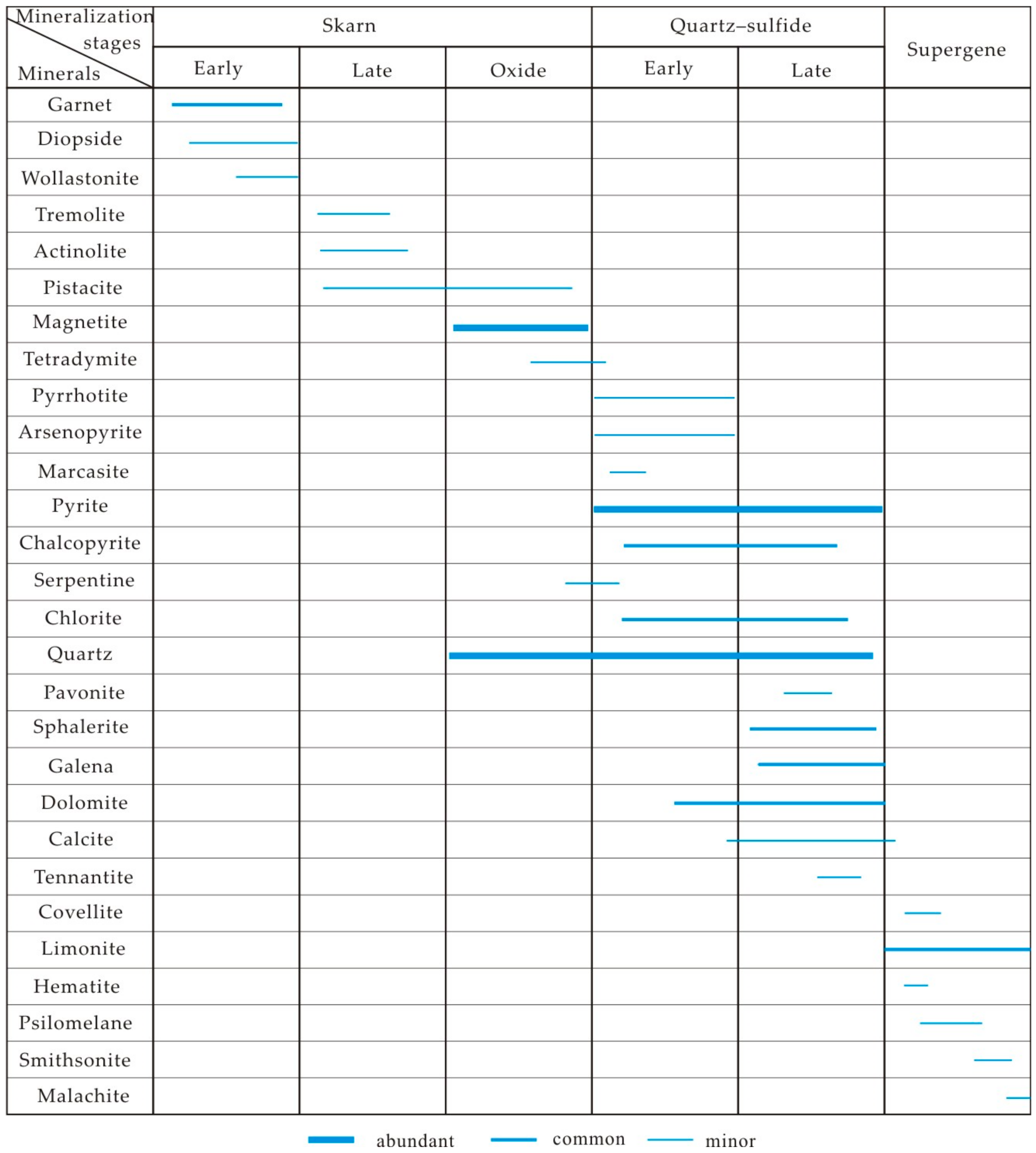
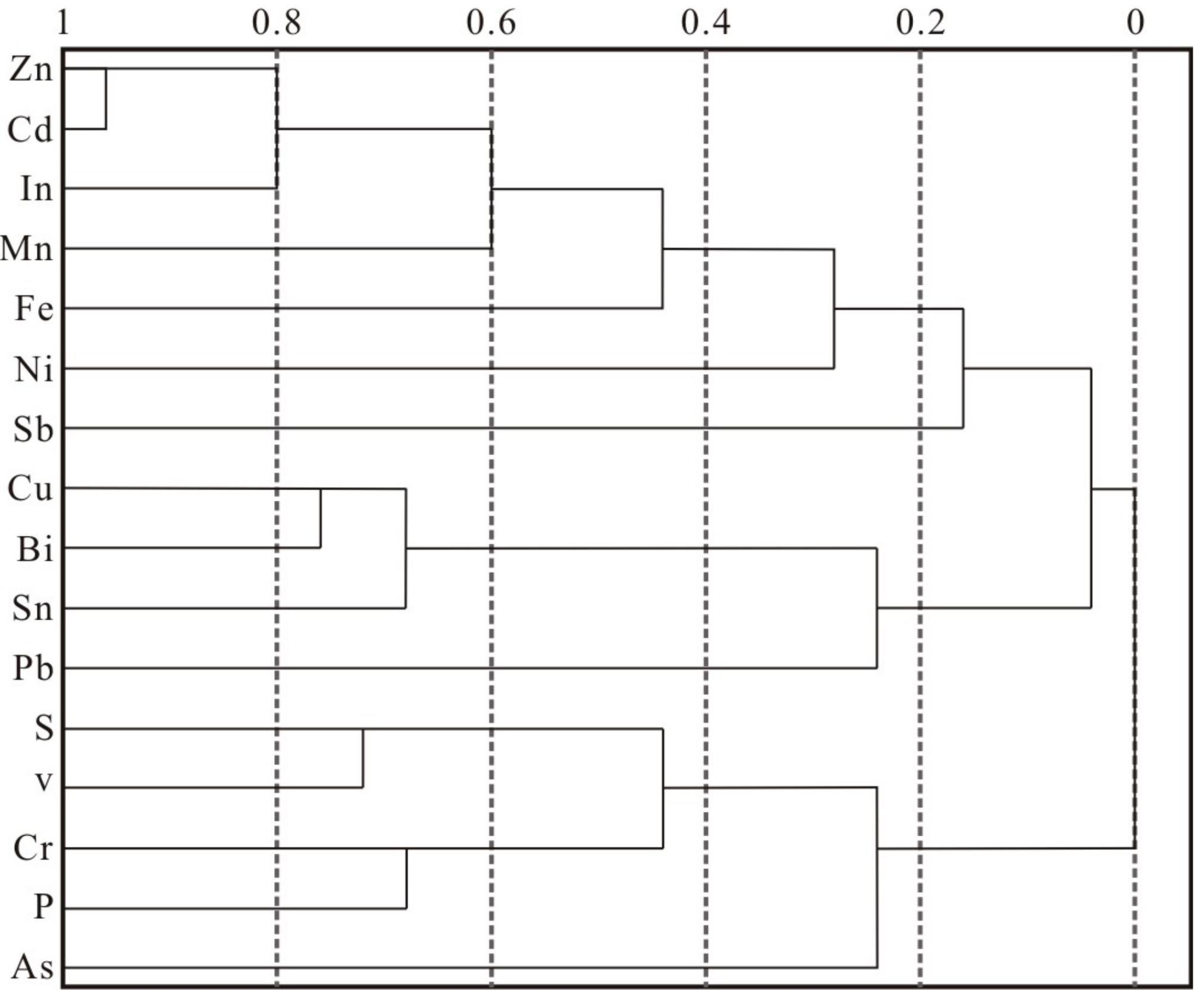
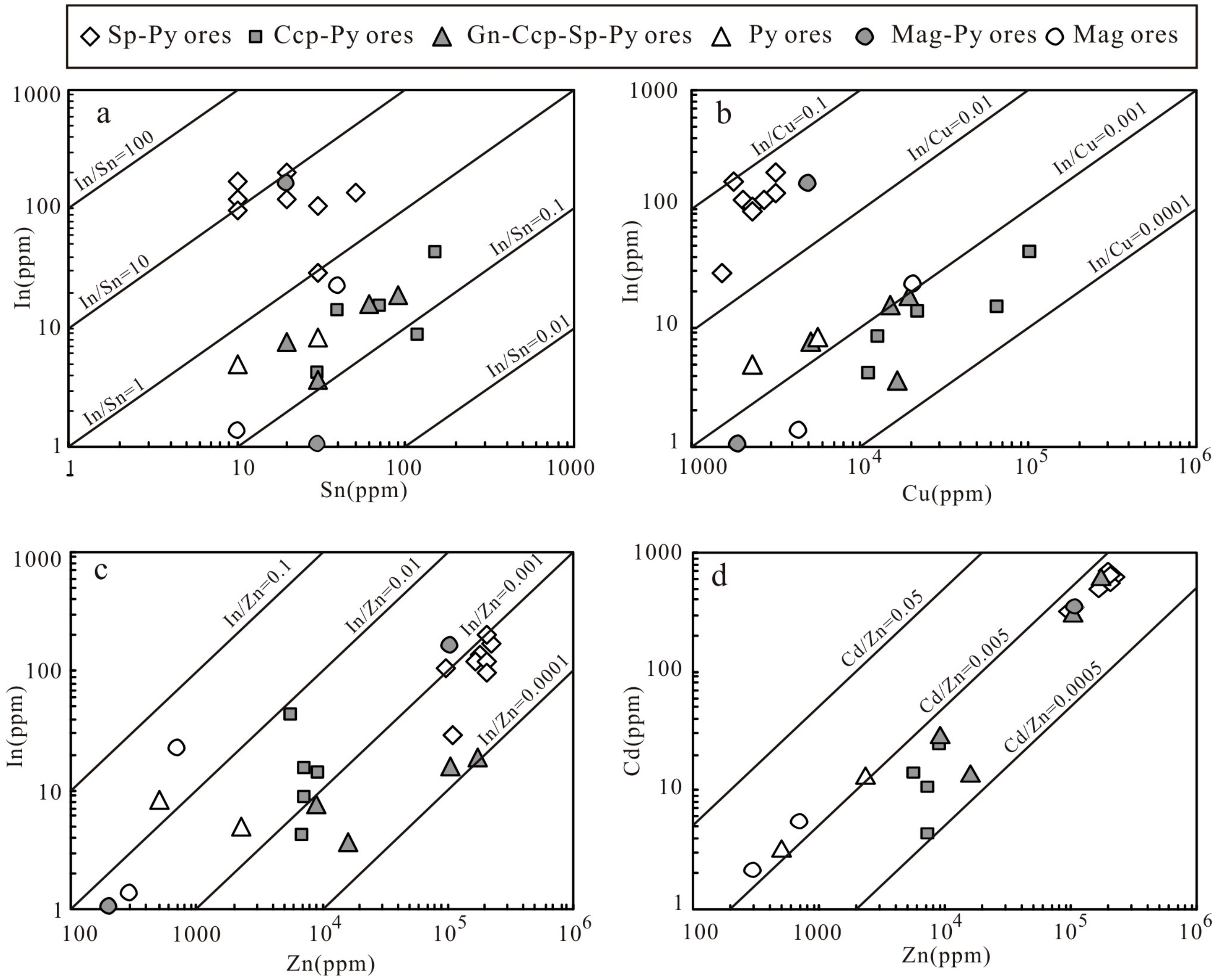
| Sample No | Location | Ore Types | Description | |
|---|---|---|---|---|
| Laohukou Block (LB) | ||||
| 1 | L1 | Level 40 m | Py-Ccp ores | Massive, coarse grained, Py > Ccp, Apy (10%) |
| 2 | L3 | Level 12 m | Py-Ccp ores | Loose sulfides, fine grained, Py > Sp |
| 3 | L6 | Level 12 m in No. 8-1 orebody | Py ores | Massive, medium-fine grained, Py (50%) > Ccp (10%) |
| 4 | L7 | Same as above | Py ores | Same as above |
| 5 | L8 | Level 19 m in No. I orebody | Py-Sp-Gn-Ccp ores | Massive, medium-fine grained, Py (20%) > Sp > Ccp (5%) > Gn |
| 6 | L9 | Same as above | Py-Sp-Gn-Ccp ores | Loose sulfides, fine grained, Py > Sp > Ccp |
| 7 | L10 | Same as above | Py-Ccp ores | Massive, medium-fine grained, Sp > Py |
| 8 | L12 | Same as above, | Py-Sp-Gn-Ccp ores | Massive, medium-fine grained, Sp (30%) > Py > Ccp > Gn |
| 9 | L14 | Level 12 m in No. I orebody | Py-Ccp ores | Massive, medium-fine grained, Py > Ccp |
| 10 | L17 | Same as above | Py-Sp-Gn-Ccp ores | Disseminated, medium-fine grained, Sp > Py > Ccp > Gn |
| Daqibaoshan Block (DB) | ||||
| 11 | D9 | Level 116 m | Mag-Py ores | Massive, coarse grained, Py > Mag (10%), contained serpentine |
| 12 | D16 | Same as above | Mag-Py ores | Massive, coarse grained, Mag > Py > Sp |
| Xiaoqibaoshan Block (XB) | ||||
| 13 | X1 | Level −29 m @ line 52 | Py-Ccp ores | Disseminated, medium-fine grained, Py > Ccp > Sp |
| 14 | X6 | Level −43 m @ line 58 | Sp-Py ores | Disseminated, medium-fine grained, Py > Sp |
| 15 | X7 | Level −43 m @ line 68 | Sp-Py ores | Disseminated, medium-fine grained, Sp > Py |
| 16 | X8 | Same as above | Sp-Py ores | Disseminated, medium-fine grained, Py > Sp |
| 17 | X9 | Same as above | Sp-Py ores | Disseminated, medium-fine grained, Sp > Py |
| 18 | X10 | Same as above | Sp-Py ores | Same as above |
| 19 | X11 | Level −43 m @ line 70 | Sp-Py ores | Same as above |
| 20 | X12 | Level −45 m @ line 62 | Sp-Py ores | Same as above |
| 21 | X13 | Level −43 m @ line 58 | Py-Ccp ores | Disseminated, medium-fine grained, Sp > Py |
| Jigongwan Block (JGB) | ||||
| 22 | J5 | Level 84m | Py-Ccp ores | Disseminated, medium-fine grained, Py > Ccp |
| 23 | J8 | Same as above | Mag ores | Disseminated, medium-fine grained, Mag > Py |
| 1000 In/Zn | In | Sn | Cd | Zn | Pb | Cu | Fe | Mn | Ni | Co | W | Bi | As | Sb | Ag | Cr | P | V | S | |
|---|---|---|---|---|---|---|---|---|---|---|---|---|---|---|---|---|---|---|---|---|
| Units | ppm | ppm | ppm | wt % | ppm | wt % | wt % | ppm | ppm | ppm | ppm | ppm | ppm | ppm | ppm | ppm | ppm | ppm | wt % | |
| Detection limits | 0.005 | 10 | 0.5 | 2 | 2 | 0.01 | 0.1 | 0.01 | 1 | 1 | 10 | 2 | 5 | 5 | 0.5 | 1 | 10 | 1 | 0.1 | |
| Sp-Py ores | ||||||||||||||||||||
| X6 | 2.63 | 28.9 | 30 | 351 | 11.00 | 16,100 | 0.15 | 35 | 501 | 1 | <1 | 10 | 35 | 2920 | 115 | 35.4 | 12 | 10 | 5 | 45.7 |
| X7 | 7.48 | 135 | 50 | 535 | 18.05 | 2720 | 0.32 | 31.2 | 949 | 1 | <1 | 40 | 59 | 1520 | 81 | 48.2 | 9 | 40 | 4 | 43.4 |
| X8 | 7.12 | 121 | 20 | 497 | 17.00 | 494 | 0.27 | 25.4 | 799 | 12 | 4 | 10 | 81 | 603 | 72 | 34 | 19 | 50 | 7 | 36.2 |
| X9 | 7.66 | 170 | 10 | 622 | 22.20 | 105 | 0.18 | 25.6 | 801 | 61 | 50 | <10 | 20 | 255 | 105 | 9.1 | 7 | 20 | 2 | 38 |
| X10 | 5.84 | 121.5 | 10 | 563 | 20.80 | 313 | 0.2 | 27.2 | 863 | 41 | 36 | 30 | 69 | 197 | 21 | 17.3 | 5 | 20 | 1 | 39.6 |
| X11 | 10.89 | 106.5 | 30 | 315 | 9.78 | 6330 | 0.23 | 36.1 | 491 | 3 | 7 | 20 | 375 | 11,200 | 158 | >100 | 7 | 20 | 3 | 45.6 |
| X12 | 4.78 | 96.5 | 10 | 711 | 20.20 | 186 | 0.23 | 32.1 | 643 | 21 | 14 | 30 | 244 | 586 | 129 | 23.4 | 12 | 20 | 4 | 44.8 |
| L10 | 9.95 | 203 | 20 | 645 | 20.40 | 890 | 0.32 | 32 | 2730 | <1 | <1 | 10 | 85 | 750 | 50 | 38.1 | 10 | 10 | 3 | 44.8 |
| Mean (n = 8) | 7.04 | 122.8 | 23 | 530 | 17.43 | 3392 | 0.24 | 30.6 | 972 | 18 | 14 | 19 | 121 | 2254 | 91 | 38.2 | 10 | 24 | 4 | 42.3 |
| Py-Ccp ores | ||||||||||||||||||||
| X13 | 11.51 | 8.52 | 120 | 4.3 | 0.74 | 290 | 1.3 | 31.7 | <5 | 3 | 1 | 10 | 268 | 1100 | 30 | 72.2 | 9 | 20 | 3 | 36.9 |
| X1 | 5.84 | 4.09 | 30 | <0.5 | 0.7 | 16 | 1.15 | 32.7 | 41 | 10 | <1 | <10 | 896 | 130 | 400 | 24.9 | 19 | 70 | 10 | 37.5 |
| L1 | 74.91 | 42.7 | 150 | 13.7 | 0.57 | 287 | 10.25 | 39.7 | 34 | 25 | 24 | <10 | 2690 | 1320 | 59 | >100 | 9 | 10 | 4 | 46.5 |
| L3 | 14.68 | 13.65 | 40 | 24.4 | 0.93 | 1140 | 2.24 | 38.3 | 90 | 16 | 18 | <10 | 586 | 2350 | 103 | 80.5 | 15 | 40 | 16 | 44.7 |
| L14 | 20.75 | 15.15 | 70 | 10.6 | 0.73 | 398 | 6.69 | 41.8 | 29 | 14 | 22 | <10 | 353 | 729 | 28 | >100 | 9 | 10 | 3 | 48.8 |
| Mean (n = 5) | 25.54 | 16.82 | 82 | 10.6 | 0.73 | 426 | 4.33 | 36.8 | 39 | 14 | 13 | 10 | 959 | 1126 | 124 | 75.5 | 12 | 30 | 7 | 42.9 |
| Py-Sp-Gn-Ccp ores | ||||||||||||||||||||
| L8 | 2.21 | 3.61 | 30 | 13.7 | 1.63 | 2930 | 1.68 | 43 | 43 | 1 | 9 | <10 | 410 | 368 | 49 | >100 | 13 | 220 | 8 | 50.5 |
| L9 | 8.36 | 7.61 | 20 | 29.2 | 0.91 | 2500 | 0.51 | 30.5 | 90 | 10 | 8 | 10 | 208 | 394 | 16 | 34.6 | 22 | 140 | 24 | 35.4 |
| L12 | 1.48 | 15.7 | 60 | 303 | 10.6 | 34,300 | 1.53 | 34.9 | 752 | 5 | 3 | 50 | 901 | 1810 | 66 | >100 | 14 | 10 | 3 | 45.6 |
| L17 | 1.09 | 18.95 | 90 | 634 | 17.45 | 52,600 | 1.96 | 30.5 | 1340 | 3 | <1 | 40 | 464 | 1230 | 98 | >100 | 18 | 20 | 4 | 43.7 |
| Mean (n = 4) | 3.29 | 11.47 | 50 | 245.0 | 7.65 | 23,083 | 1.42 | 34.7 | 556 | 5 | 5 | 28 | 496 | 951 | 57 | 84.7 | 17 | 98 | 10 | 43.8 |
| Py ores | ||||||||||||||||||||
| L6 | 21.52 | 4.95 | 10 | 13.5 | 0.23 | 155 | 0.23 | 41.1 | 649 | 1 | 35 | <10 | 100 | 204 | <5 | 15 | 8 | <10 | 13 | 41.3 |
| L7 | 165.6 | 8.28 | 30 | 3.3 | 0.05 | 91 | 0.56 | 39.9 | 673 | 2 | 17 | 10 | 182 | 89 | <5 | 24.9 | 13 | 30 | 22 | 39.1 |
| Mean (n = 2) | 93.56 | 6.62 | 20 | 8.4 | 0.14 | 123 | 0.40 | 40.5 | 661 | 1 | 26 | 10 | 141 | 147 | <5 | 20.0 | 11 | 20 | 18 | 40.2 |
| Mag-Py ores | ||||||||||||||||||||
| D9 | 52.25 | 1.05 | 30 | 0.9 | 0.02 | 37 | 0.19 | 41.8 | 208 | 4 | 3 | 1130 | 35 | 45 | <5 | 4 | 7 | 70 | 23 | 33.1 |
| D16 | 15.07 | 162 | 20 | 340 | 10.75 | 38 | 0.49 | 35.6 | 196 | 1 | <1 | 40 | 57 | 40 | <5 | 8.2 | 20 | 80 | 12 | 33.8 |
| Mean (n = 2) | 33.66 | 81.53 | 25 | 170.5 | 5.39 | 38 | 0.34 | 38.7 | 202 | 3 | 2 | 585 | 46 | 43 | <5 | 6.1 | 14 | 75 | 188 | 33.5 |
| Mag ores | ||||||||||||||||||||
| J5 | 324.29 | 22.7 | 40 | 5.5 | 0.07 | 71 | 2.06 | 24 | 1330 | 30 | 69 | 60 | 29 | 62 | <5 | 43.3 | 40 | 320 | 63 | 24.7 |
| J8 | 45.67 | 1.37 | 10 | 2.1 | 0.03 | 8 | 0.43 | 61.6 | 801 | 6 | 45 | 30 | 18 | 6 | <5 | 8.9 | 13 | 40 | 52 | 5.8 |
| Mean (n = 2) | 184.98 | 12.04 | 25 | 3.8 | 0.05 | 40 | 1.25 | 42.8 | 1066 | 18 | 57 | 45 | 24 | 34 | <5 | 26.1 | 26.50 | 180 | 58 | 15.3 |
| Zn | Cu | Fe | S | In | As | Bi | Cd | Cr | Mn | Ni | P | Pb | Sb | Sn | V | |
|---|---|---|---|---|---|---|---|---|---|---|---|---|---|---|---|---|
| Zn | 1.00 | |||||||||||||||
| Cu | 0.35 | 1.00 | ||||||||||||||
| Fe | 0.54 | 0.17 | 1.00 | |||||||||||||
| S | 0.25 | 0.27 | 0.33 | 1.00 | ||||||||||||
| In | 0.81 | 0.25 | 0.45 | 0.13 | 1.00 | |||||||||||
| As | 0.09 | 0.04 | 0.01 | 0.30 | 0.12 | 1.00 | ||||||||||
| Bi | 0.26 | 0.81 | 0.11 | 0.32 | 0.22 | 0.10 | 1.00 | |||||||||
| Cd | 0.99 | 0.35 | 0.52 | 0.26 | 0.77 | 0.10 | 0.25 | 1.00 | ||||||||
| Cr | 0.23 | 0.03 | 0.30 | 0.37 | 0.20 | 0.23 | 0.09 | 0.20 | 1.00 | |||||||
| Mn | 0.57 | 0.30 | 0.27 | 0.09 | 0.52 | 0.05 | 0.31 | 0.59 | 0.11 | 1.00 | ||||||
| Ni | 0.31 | 0.16 | 0.41 | 0.08 | 0.30 | 0.18 | 0.09 | 0.25 | 0.01 | 0.02 | 1.00 | |||||
| P | 0.34 | 0.05 | 0.16 | 0.28 | 0.22 | 0.21 | 0.15 | 0.35 | 0.76 | 0.04 | 0.08 | 1.00 | ||||
| Pb | 0.26 | 0.00 | 0.12 | 0.24 | 0.19 | 0.16 | 0.12 | 0.32 | 0.09 | 0.23 | 0.23 | 0.18 | 1.00 | |||
| Sb | 0.13 | 0.05 | 0.22 | 0.24 | 0.02 | 0.27 | 0.25 | 0.13 | 0.00 | 0.14 | 0.05 | 0.15 | 0.10 | 1.00 | ||
| Sn | 0.26 | 0.76 | 0.01 | 0.27 | 0.29 | 0.07 | 0.71 | 0.24 | 0.06 | 0.24 | 0.08 | 0.15 | 0.29 | 0.02 | 1.00 | |
| V | 0.51 | 0.10 | 0.30 | 0.80 | 0.38 | 0.25 | 0.23 | 0.49 | 0.65 | 0.08 | 0.02 | 0.64 | 0.22 | 0.32 | 0.22 | 1.00 |
| Sample Nos | Zn | Fe | Mn | Cd | Sn | In | Ge | S | Se | Total |
|---|---|---|---|---|---|---|---|---|---|---|
| X6-sp01 | 51.75 | 11.54 | 0.21 | 0.13 | 0.00 | 0.00 | 0.00 | 35.37 | 0.00 | 98.99 |
| X6-sp02 | 52.35 | 11.73 | 0.17 | 0.21 | 0.00 | 0.04 | 0.00 | 34.91 | 0.01 | 99.42 |
| X6-sp03 | 53.34 | 11.79 | 0.13 | 0.18 | 0.00 | 0.07 | 0.04 | 34.03 | 0.00 | 99.57 |
| X7-sp01 | 52.22 | 11.78 | 0.33 | 0.17 | 0.00 | 0.06 | 0.01 | 34.19 | 0.02 | 98.77 |
| X7-sp02 | 53.03 | 11.91 | 0.18 | 0.19 | 0.00 | 0.06 | 0.00 | 34.44 | 0.02 | 99.82 |
| X7-sp03 | 53.90 | 10.95 | 0.33 | 0.13 | 0.00 | 0.06 | 0.01 | 33.63 | 0.00 | 99.00 |
| X7-sp04 | 52.42 | 11.51 | 0.45 | 0.15 | 0.00 | 0.04 | 0.00 | 34.30 | 0.00 | 98.86 |
| X7-sp05 | 54.51 | 11.46 | 0.31 | 0.16 | 0.00 | 0.02 | 0.00 | 34.00 | 0.00 | 100.47 |
| X7-sp06 | 52.78 | 11.16 | 0.40 | 0.16 | 0.00 | 0.10 | 0.02 | 34.02 | 0.00 | 98.63 |
| X8-sp01 | 52.98 | 11.54 | 0.32 | 0.13 | 0.00 | 0.00 | 0.02 | 34.44 | 0.00 | 99.43 |
| X8-sp02 | 53.74 | 11.61 | 0.31 | 0.16 | 0.00 | 0.00 | 0.00 | 34.04 | 0.00 | 99.85 |
| X8-sp03 | 52.27 | 11.86 | 0.20 | 0.19 | 0.00 | 0.07 | 0.00 | 34.24 | 0.01 | 98.84 |
| X10-sp01 | 53.97 | 11.60 | 0.17 | 0.16 | 0.00 | 0.00 | 0.02 | 34.21 | 0.00 | 100.14 |
| X10-sp03 | 52.41 | 12.23 | 0.23 | 0.15 | 0.00 | 0.09 | 0.02 | 34.08 | 0.00 | 99.20 |
| X11-sp02 | 53.19 | 11.24 | 0.14 | 0.17 | 0.00 | 0.02 | 0.00 | 34.71 | 0.03 | 99.51 |
| X11-sp03 | 54.09 | 10.34 | 0.66 | 0.17 | 0.00 | 0.04 | 0.00 | 34.29 | 0.00 | 99.59 |
| X11-sp04 | 53.47 | 11.11 | 0.18 | 0.12 | 0.04 | 0.01 | 0.02 | 34.32 | 0.00 | 99.28 |
| X11-sp05 | 53.84 | 11.37 | 0.16 | 0.18 | 0.00 | 0.00 | 0.00 | 33.54 | 0.00 | 99.09 |
| X12-sp02 | 53.41 | 11.03 | 0.21 | 0.17 | 0.02 | 0.05 | 0.00 | 34.19 | 0.00 | 99.09 |
| L10-sp01 | 56.10 | 11.55 | 0.32 | 0.12 | 0.00 | 0.00 | 0.00 | 33.57 | 0.00 | 101.66 |
| L10-sp02 | 53.69 | 12.07 | 0.36 | 0.12 | 0.00 | 0.00 | 0.00 | 33.07 | 0.00 | 99.31 |
| L10-sp05 | 53.31 | 11.52 | 0.34 | 0.12 | 0.00 | 0.00 | 0.00 | 33.61 | 0.00 | 98.90 |
| L10-sp06 | 55.76 | 11.46 | 0.30 | 0.08 | 0.00 | 0.00 | 0.00 | 33.84 | 0.00 | 101.44 |
| L14-sp02 | 56.00 | 8.78 | 0.64 | 0.21 | 0.00 | 0.00 | 0.00 | 32.89 | 0.00 | 98.51 |
| J7-sp06 | 54.73 | 11.57 | 0.25 | 0.34 | 0.00 | 0.00 | 0.00 | 33.60 | 0.00 | 100.50 |
© 2017 by the author. Licensee MDPI, Basel, Switzerland. This article is an open access article distributed under the terms and conditions of the Creative Commons Attribution (CC BY) license (http://creativecommons.org/licenses/by/4.0/).
Share and Cite
Liu, J. Indium Mineralization in a Sn-Poor Skarn Deposit: A Case Study of the Qibaoshan Deposit, South China. Minerals 2017, 7, 76. https://doi.org/10.3390/min7050076
Liu J. Indium Mineralization in a Sn-Poor Skarn Deposit: A Case Study of the Qibaoshan Deposit, South China. Minerals. 2017; 7(5):76. https://doi.org/10.3390/min7050076
Chicago/Turabian StyleLiu, Jianping. 2017. "Indium Mineralization in a Sn-Poor Skarn Deposit: A Case Study of the Qibaoshan Deposit, South China" Minerals 7, no. 5: 76. https://doi.org/10.3390/min7050076




